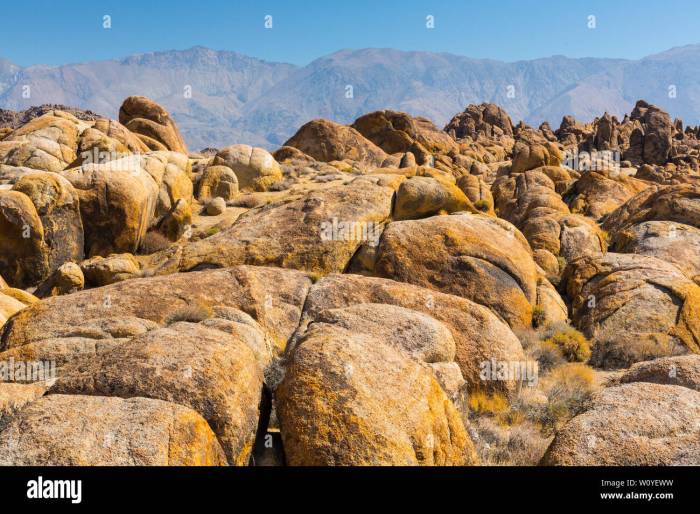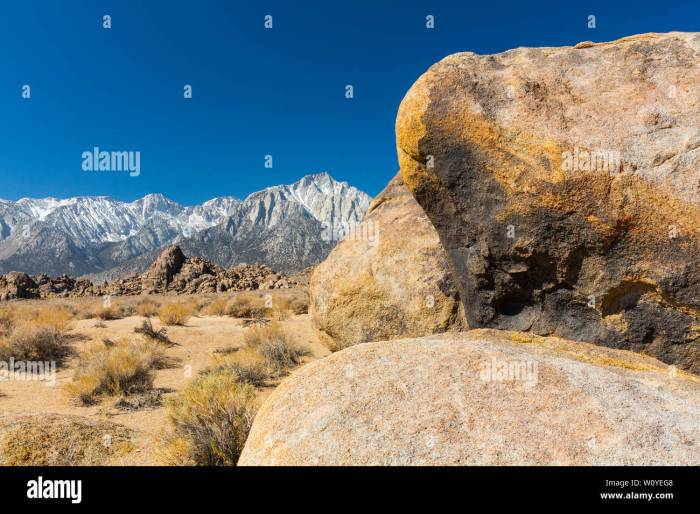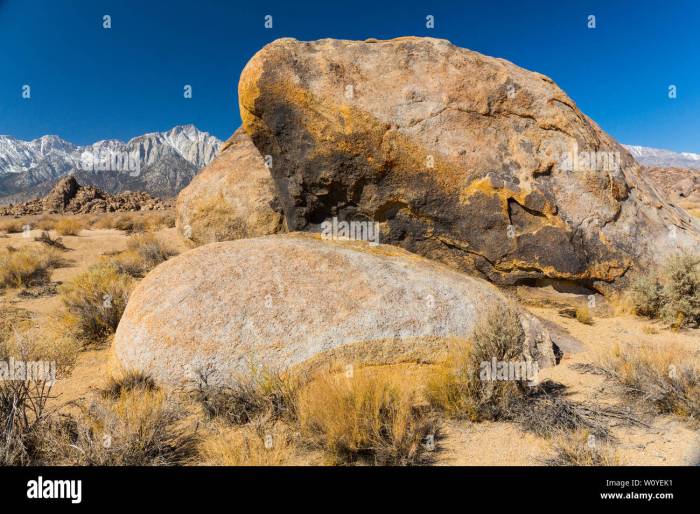Nestled in the heart of California’s Mojave Desert, Alabama Hills stand as a testament to the power of nature and the enduring legacy of human history. With their otherworldly rock formations, diverse ecosystem, and rich cultural heritage, the Alabama Hills have captivated artists, filmmakers, and outdoor enthusiasts alike.
From the intricate geological formations shaped by millions of years of erosion to the vibrant plant and animal life that calls this unique environment home, the Alabama Hills offer a breathtaking tapestry of natural beauty. But beyond their physical attributes, these hills hold a deep cultural and historical significance, having served as a gathering place for Native American tribes, a backdrop for early Hollywood films, and a source of inspiration for countless artists.
Geological Significance of Alabama Hills

The Alabama Hills are a unique and geologically significant area located in the eastern Sierra Nevada mountains of California. The hills are composed of a variety of rock formations, including granite, gneiss, and schist, which have been shaped by millions of years of erosion and weathering. The result is a landscape that is both beautiful and scientifically fascinating.
Unique Geological Formations, Alabama hills
One of the most striking features of the Alabama Hills is the presence of large, rounded boulders that are scattered throughout the landscape. These boulders are the result of weathering and erosion of the underlying granite. Over time, the granite has been broken down into smaller pieces, which have been transported by wind and water to their current locations.
Types of Rocks and Minerals
The Alabama Hills are composed of a variety of rocks and minerals, including granite, gneiss, schist, and marble. Granite is the most common rock type in the area, and it is composed of quartz, feldspar, and mica. Gneiss is a metamorphic rock that is formed when granite is subjected to heat and pressure. Schist is another metamorphic rock that is formed when granite is subjected to even greater heat and pressure. Marble is a metamorphic rock that is formed when limestone is subjected to heat and pressure.
The Alabama Hills, with their otherworldly rock formations and sweeping vistas, offer a breathtaking backdrop for hikers. Explore hidden canyons, scale granite domes, and soak in the stunning scenery. Alabama Hills ranks among the best hiking trails in the US , providing an unforgettable adventure in the heart of the Eastern Sierra.
Role of Erosion and Weathering
Erosion and weathering have played a major role in shaping the landscape of the Alabama Hills. Wind and water have eroded the granite boulders, creating the rounded shapes that are so characteristic of the area. Weathering has also played a role in breaking down the granite into smaller pieces, which have been transported by wind and water to their current locations.
Ecological Diversity of Alabama Hills
The Alabama Hills, with its unique geological formations, is also home to a diverse array of plant and animal species. The unique environment, characterized by arid conditions and rugged terrain, supports a resilient ecosystem that has adapted to these challenging conditions.
Flora
The plant life in the Alabama Hills is predominantly desert vegetation, with various species of shrubs, wildflowers, and cacti thriving in the harsh conditions. Creosote bushes, known for their ability to withstand extreme heat and drought, are common throughout the region. Other notable plant species include Joshua trees, yuccas, and wildflowers such as desert sunflowers and lupines, which bloom in vibrant colors during the spring.
Fauna
The animal life in the Alabama Hills is equally diverse, with a range of species adapted to the arid environment. Reptiles are well-represented, with lizards, snakes, and turtles being common sightings. Birds such as hawks, eagles, and owls are often seen soaring above the hills, while mammals like coyotes, bobcats, and mule deer roam the rugged terrain. The area also provides habitat for several species of bats, which play a crucial role in the ecosystem as pollinators and insect controllers.
Conservation Efforts
Recognizing the ecological importance of the Alabama Hills, conservation efforts are in place to protect its unique ecosystem. The area has been designated as a National Natural Landmark, which provides federal protection for its geological and ecological features. Additionally, the Bureau of Land Management (BLM) manages the Alabama Hills as a recreation area, implementing measures to minimize human impact on the environment.
Cultural and Historical Importance of Alabama Hills

The Alabama Hills have been a significant cultural and historical site for centuries, inhabited by various groups throughout history. Its unique geological formations and scenic beauty have attracted both Native American tribes and early settlers, leaving behind a rich tapestry of cultural and historical significance.
Native American Heritage
The Alabama Hills hold deep cultural significance for Native American tribes, particularly the Paiute and Serrano people. These tribes have lived in the area for thousands of years, utilizing the hills for hunting, gathering, and spiritual practices. Archaeological evidence suggests that the hills were a vital part of their cultural landscape, with numerous petroglyphs and pictographs depicting their history and beliefs.
Early Settlers and Explorers
In the 19th century, the Alabama Hills became a significant landmark for early settlers and explorers. The hills were a prominent feature along the Old Spanish Trail, a major trade route between Santa Fe, New Mexico, and Los Angeles, California. Settlers and travelers often used the hills as a reference point and a place to rest and resupply.
Movie History
In the 20th century, the Alabama Hills gained prominence as a filming location for Hollywood movies. The hills’ unique rock formations and rugged terrain have served as a backdrop for numerous Western films, including “The Searchers,” “Giant,” and “Gladiator.” The hills’ association with the film industry has further cemented their cultural significance and made them a popular tourist destination.
The Alabama Hills, located near Lone Pine, California, offer a unique and picturesque setting for family vacations. With its towering rock formations, vast open spaces, and proximity to Mount Whitney, the area provides ample opportunities for hiking, camping, rock climbing, and wildlife viewing.
Whether you’re looking for a scenic road trip or an adventurous getaway, the Alabama Hills is a destination that caters to families of all ages. Best family vacation spots often include outdoor activities, and the Alabama Hills has plenty to offer in that regard.
Artistic Inspiration and Film Location

Alabama Hills has captivated the imaginations of artists and filmmakers alike, becoming a popular destination for creative expression. Its unique geological formations, expansive vistas, and dramatic lighting conditions have inspired countless works of art and cinematic masterpieces.
Distinctive Visual Characteristics
The Alabama Hills’ allure stems from its extraordinary visual characteristics. The area features towering rock formations, sculpted by centuries of erosion, that rise from the desert floor like ancient monoliths. These formations, composed of granite and gneiss, exhibit a rich palette of colors, ranging from warm hues of pink and orange to cool grays and blacks. The play of light and shadow across these rugged surfaces creates a mesmerizing spectacle, especially during sunrise and sunset.
Examples of Artistic Inspiration
The Alabama Hills has served as a backdrop for numerous iconic films, including “The Lone Ranger” (1956), “Gunga Din” (1939), and “Gladiator” (2000). The area’s distinctive rock formations and expansive vistas have provided the perfect setting for Westerns, historical epics, and science fiction films alike. Artists have also been drawn to the Alabama Hills, with painters, photographers, and sculptors capturing its ethereal beauty on canvas, film, and stone.
Outdoor Recreation Opportunities

The Alabama Hills offer a wide range of outdoor recreation opportunities for visitors of all ages and abilities. From hiking and camping to rock climbing and wildlife viewing, there’s something for everyone to enjoy in this beautiful natural setting.
Alabama Hills is an awe-inspiring natural wonder, but if you’re seeking family-friendly accommodations, consider exploring the nearby family-friendly resorts. These resorts offer a range of amenities and activities tailored to families, ensuring a memorable and enjoyable vacation. After a day of adventure in the Alabama Hills, you can return to the comforts of these resorts, creating lasting memories with your loved ones.
Hiking
The Alabama Hills are home to an extensive network of hiking trails, ranging from easy nature walks to challenging ascents. Some of the most popular trails include the Mobius Arch Trail, the Whitney Portal Trail, and the Cottonwood Creek Trail. These trails offer stunning views of the surrounding mountains, valleys, and rock formations.
Camping
There are several campgrounds located within the Alabama Hills, offering a range of camping options from primitive campsites to RV hookups. Camping in the Alabama Hills is a great way to experience the area’s natural beauty and tranquility. Visitors can enjoy stargazing, campfires, and hiking right from their campsite.
Rock Climbing
The Alabama Hills are a world-renowned rock climbing destination. The area’s unique rock formations offer a variety of climbing challenges for climbers of all levels. There are over 1,000 established climbing routes in the Alabama Hills, ranging from easy top-rope climbs to challenging trad routes.
Tips for Planning a Safe and Enjoyable Outdoor Adventure
- Plan your trip in advance and check the weather forecast before you go.
- Bring plenty of water and snacks, especially if you are planning on hiking or climbing.
- Wear appropriate clothing and footwear for the weather and activity you are planning.
- Be aware of your surroundings and stay on designated trails.
- Leave no trace and pack out everything you pack in.
Conclusion

As we delve into the multifaceted world of Alabama Hills, we will uncover the secrets of its geological origins, explore the intricate web of life that thrives within its boundaries, and trace the human history that has unfolded amidst its rugged landscapes. Whether you are an artist seeking inspiration, a hiker yearning for adventure, or simply a curious soul eager to discover the hidden treasures of the Mojave Desert, Alabama Hills awaits with a promise of wonder and enchantment.
FAQ
What is the best time to visit Alabama Hills?
The best time to visit Alabama Hills is during the spring or fall, when the weather is mild and pleasant. However, the hills are accessible year-round, offering unique experiences in each season.
Are there any fees associated with visiting Alabama Hills?
No, there are no entrance or parking fees for visiting Alabama Hills.
What are some popular activities in Alabama Hills?
Popular activities in Alabama Hills include hiking, camping, rock climbing, photography, and stargazing.
Are there any guided tours available for Alabama Hills?
Yes, there are several guided tours available for Alabama Hills, ranging from short hikes to extended backpacking trips.